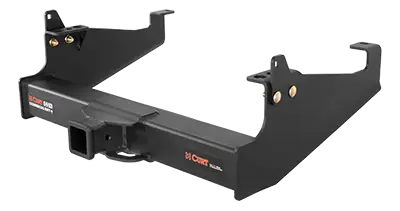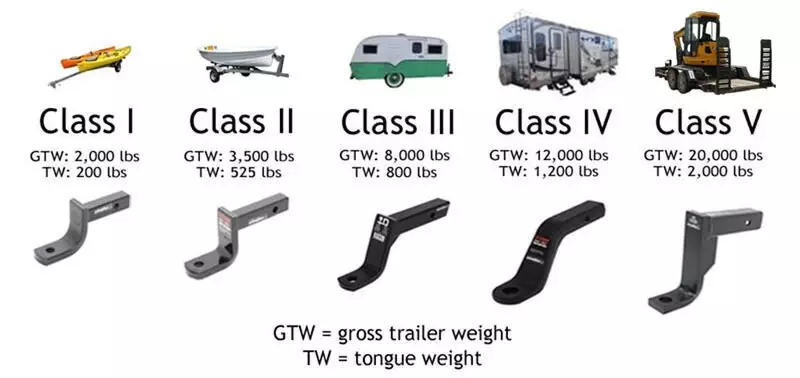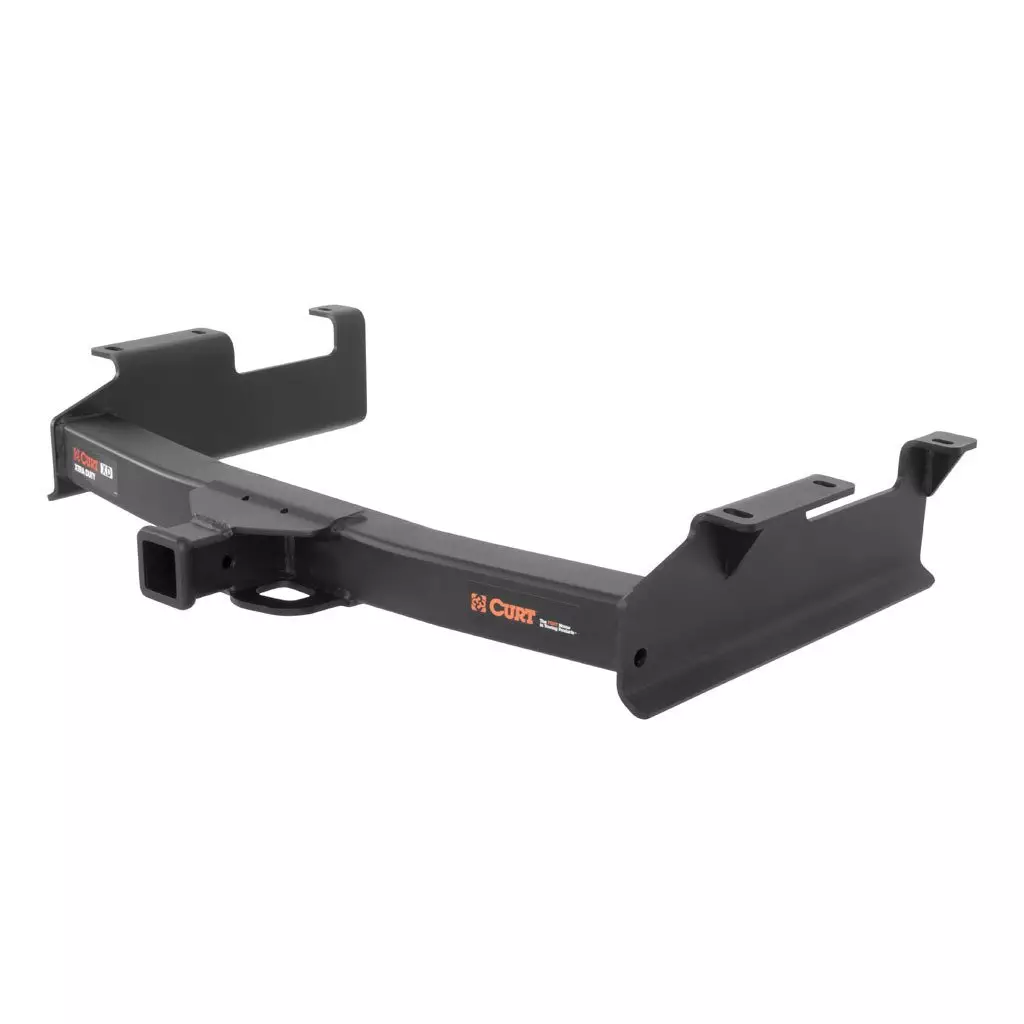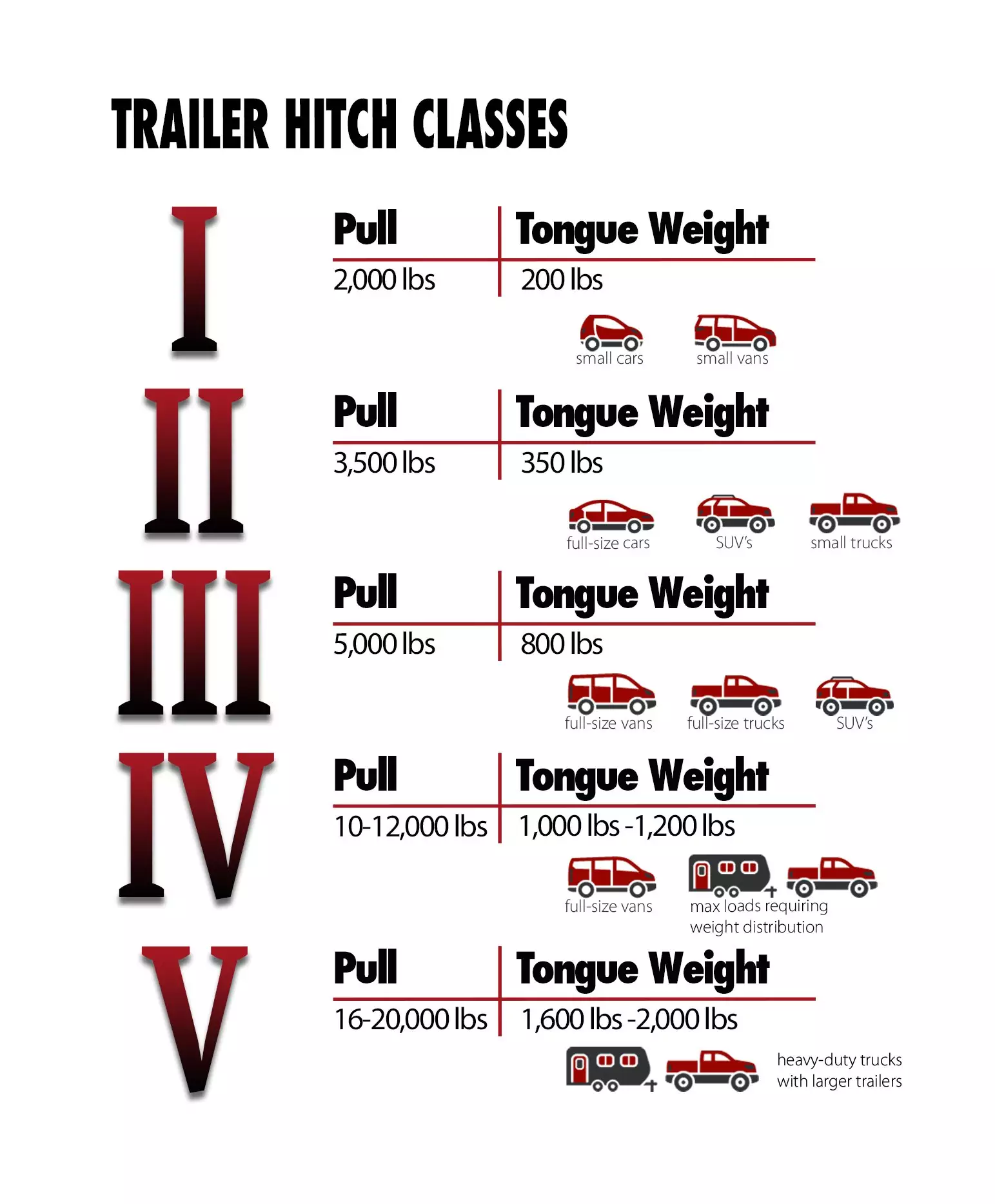Have you ever wondered what exactly Class 5 towing equipment entails? Whether you’re a seasoned expert or a newbie in the world of towing, understanding the different classes of towing equipment can be a challenge. In this article, we’ll unravel the mystery behind Class 5 towing equipment and give you a comprehensive overview of its features and capabilities. So, buckle up and get ready to discover what sets Class 5 towing equipment apart from the rest.

This image is property of www.curtmfg.com.
What is Class 5 Towing Equipment?
Definition of Class 5 Towing Equipment
Class 5 towing equipment refers to a specific classification of towing hitches and related accessories that are designed to handle heavy-duty towing tasks. It is the highest weight rating class for hitches and is capable of towing up to 18,000 pounds. Class 5 towing equipment is commonly used for larger trailers, such as RVs, horse trailers, and heavy-duty utility trailers.
Importance of Class 5 Towing Equipment
Class 5 towing equipment is of great importance for individuals or businesses that frequently tow heavy loads. It provides the necessary strength and stability to safely tow heavy trailers, ensuring a smooth and secure towing experience. Without the proper equipment, attempting to tow heavy loads can result in dangerous situations, including trailer instability, loss of control, and potential accidents.
Applications of Class 5 Towing Equipment
Class 5 towing equipment finds extensive applications in a variety of industries and activities. It is commonly used by RV owners, contractors, farmers, and other professionals who require the ability to tow heavy loads with their vehicles. Additionally, Class 5 towing equipment is often relied upon for recreational activities, such as camping, boating, and off-roading, where the transportation of large equipment or trailers is essential.
Classifications of Towing Equipment
Overview of Towing Equipment Classes
Towing equipment is classified into several classes based on their weight capacities. Each class has its own specific limitations and is suitable for different towing needs. The classes range from Class 1 to Class 5, with Class 5 being the highest weight rating. Class 5 towing equipment is designed to handle the most demanding towing tasks and offers the highest weight capacity among all the classes.
Specifics of Class 5 Towing Equipment
Class 5 towing equipment is characterized by its heavy-duty construction and high towing capacity. It typically features a 2-inch by 2-inch receiver tube, allowing for easy attachment of various towing accessories. The class 5 receiver hitches are commonly used and provide a secure connection between the trailer and the towing vehicle. Additionally, Class 5 towing equipment may include gooseneck hitches and weight distributing hitches, providing versatility and options for different towing setups.
Specifications of Class 5 Towing Equipment
Weight Capacity
Class 5 towing equipment has a weight capacity of up to 18,000 pounds. This high weight rating allows for towing of larger trailers and heavy loads, making it suitable for a wide variety of applications. It is important to ensure that the towing equipment is compatible with the weight of the trailer and the towing vehicle to maintain safe and stable towing conditions.
Receiver Size
Class 5 towing equipment typically features a 2-inch by 2-inch receiver tube. This standardized size allows for easy attachment of various towing accessories, such as hitch ball mounts and weight distribution systems. It is important to ensure that the receiver size matches the accessories being used to ensure a secure and stable connection.
Construction Material
Class 5 towing equipment is constructed using heavy-duty materials, such as steel or alloy, to provide strength and durability. The materials used are designed to handle the high towing capacities and withstand the demands of heavy towing tasks. It is important to choose towing equipment made from high-quality materials to ensure safety and longevity.
Compatibility with Vehicles
Class 5 towing equipment is designed to be compatible with a wide range of vehicles, including trucks, SUVs, and commercial vehicles. However, it is crucial to ensure that the towing equipment is compatible with the specific make and model of the towing vehicle. This ensures proper fitment and reduces the risk of equipment failure or damage during towing.
Types of Class 5 Hitches
Class 5 Receiver Hitches
Class 5 receiver hitches are the most common type of Class 5 towing equipment. They attach to the rear of the towing vehicle using a receiver tube and provide a secure connection point for the trailer. Class 5 receiver hitches are available in various designs, including fixed, adjustable, and folding options, allowing for flexibility and customization.
Class 5 Gooseneck Hitches
Class 5 gooseneck hitches are designed for towing heavy loads, such as horse trailers or large equipment trailers. They utilize a gooseneck ball, which is mounted in the bed of the towing vehicle, providing a strong and stable connection. Class 5 gooseneck hitches offer increased maneuverability and improved weight distribution compared to receiver hitches.
Class 5 Weight Distributing Hitches
Class 5 weight distributing hitches are used for towing large and heavy trailers while improving stability and weight distribution. They employ spring bars that redistribute the weight of the trailer across the towing vehicle and trailer axles. Class 5 weight distributing hitches are ideal for towing heavy loads and provide a smoother and more controlled towing experience.

This image is property of www.etrailer.com.
Benefits of Class 5 Towing Equipment
Enhanced Towing Capacity
One of the key benefits of Class 5 towing equipment is its high towing capacity. With a weight rating of up to 18,000 pounds, it allows for the towing of heavy loads with ease. Whether it’s transporting heavy equipment, hauling a large RV, or towing a horse trailer, Class 5 towing equipment provides the necessary strength and stability to handle the task.
Versatility
Class 5 towing equipment offers versatility in terms of towing options. With various types of hitches available, such as receiver hitches, gooseneck hitches, and weight distributing hitches, users can choose the option that best suits their specific towing needs. Whether it’s towing a boat, a camper, or a construction trailer, Class 5 towing equipment provides the flexibility to meet different towing requirements.
Durability
Class 5 towing equipment is built to withstand heavy-duty towing tasks. The use of high-quality materials and robust construction ensures durability and longevity. Class 5 towing equipment is designed to withstand the rigors of towing heavy loads, including bumps, vibrations, and other stresses. Investing in Class 5 towing equipment ensures that it will hold up under demanding towing conditions.
Safety Features
Class 5 towing equipment is equipped with various safety features to enhance the towing experience and ensure safety on the road. From integrated safety chains and breakaway systems to built-in sway control mechanisms, Class 5 towing equipment offers added safety measures to prevent accidents and maintain trailer stability during towing.
Considerations when Choosing Class 5 Towing Equipment
Vehicle Compatibility
When choosing Class 5 towing equipment, it is important to consider the compatibility with the towing vehicle. The towing equipment should match the make and model of the vehicle to ensure proper fitment and compatibility. It is also essential to check the towing capacity and recommended towing specifications set by the vehicle manufacturer.
Intended Use
Before selecting Class 5 towing equipment, it is crucial to determine the intended use and the type of trailer or load to be towed. Different towing situations may require specific types of hitches or additional accessories. Considering the specific requirements and needs will help in choosing the most suitable Class 5 towing equipment for the task at hand.
Budget
Class 5 towing equipment can vary in price depending on the brand, features, and quality. It is important to set a budget and research different options within that price range. While quality and durability are important factors, finding the right balance between price and performance is crucial when purchasing Class 5 towing equipment.
Installation Requirements
Class 5 towing equipment may come with specific installation requirements, including the need for professional installation or DIY installation. It is important to consider the installation process and requirements to ensure that the towing equipment can be properly installed on the towing vehicle. This may include drilling, mounting brackets, or wiring, depending on the specific equipment and vehicle.

This image is property of www.ronstoyshop.com.
Installation and Maintenance of Class 5 Towing Equipment
Installation Process
The installation process of Class 5 towing equipment may vary depending on the specific hitch and vehicle combination. It is recommended to follow the manufacturer’s instructions for proper installation. If unsure or unfamiliar with the installation process, it is advisable to seek professional assistance to ensure a safe and secure installation.
Maintenance Tips
To ensure the longevity and performance of Class 5 towing equipment, regular maintenance is essential. This includes keeping the equipment clean and free from debris, inspecting for signs of wear or damage, and lubricating moving parts as recommended by the manufacturer. Additionally, it is important to periodically check and tighten all bolts and fasteners to maintain a secure connection.
Inspections and Repairs
Regular inspections of Class 5 towing equipment are necessary to identify any potential issues or damages that may affect its performance. If any signs of wear or malfunction are detected, it is important to address them promptly. Repairs should be carried out by qualified professionals to ensure the proper functioning and safety of the towing equipment.
Common Attachments for Class 5 Towing Equipment
Hitch Ball Mounts
Hitch ball mounts are essential attachments for Class 5 towing equipment. They provide a secure connection point for the trailer coupler and come in various sizes to accommodate different trailer weights. Hitch ball mounts attach to the receiver tube of the towing equipment, allowing for easy connection and disconnection of the trailer.
Safety Chains
Safety chains are crucial attachments that provide an additional level of security during towing. They act as a backup connection in case the main hitch connection fails. Class 5 towing equipment is often equipped with built-in attachment points for safety chains, ensuring a safe and strong connection between the towing vehicle and the trailer.
Electrical Connectors
Electrical connectors are necessary attachments for Class 5 towing equipment, allowing for the transfer of electrical signals between the towing vehicle and the trailer. These connectors enable the trailer’s taillights, turn signals, and brake lights to function properly. Class 5 towing equipment usually includes a standard 7-pin connector, but additional wiring adapters may be required for certain trailer setups.
Brake Controllers
Brake controllers are essential attachments for Class 5 towing equipment when towing a trailer with electric brakes. They allow the driver to control and adjust the braking force of the trailer. Brake controllers ensure a balanced braking system, improving safety and control while towing heavy loads. It is important to choose a brake controller compatible with the towing vehicle and trailer setup.

This image is property of www.torklift.com.
Comparing Class 5 Towing Equipment with Other Classes
Class 1 to Class 4 Compared
When comparing Class 5 towing equipment with other classes, such as Class 1 to Class 4, the key difference lies in their weight capacities. Class 1 to Class 4 hitches are designed for lighter loads and have lower weight ratings compared to Class 5. While Class 1 to Class 4 towing equipment may be sufficient for smaller trailers or lighter loads, Class 5 is the preferred choice for heavy-duty towing tasks.
Class 5 vs. Class 6 and Higher
Class 5 towing equipment is the highest weight capacity class for hitches, ranging up to 18,000 pounds. However, there are higher classes, such as Class 6 and above, which are designed for extreme towing capacities, typically found in commercial or industrial applications. Class 5 towing equipment is suitable for most heavy-duty towing needs, but for extreme towing requirements, higher classes may be necessary.
Legal Requirements for Class 5 Towing Equipment
Trailer Brake Laws
Legal requirements for Class 5 towing equipment may include trailer brake laws, depending on the weight and type of trailer being towed. Some jurisdictions require trailers over a certain weight to have functional brakes, and Class 5 towing equipment is designed to accommodate trailers equipped with electric brakes for compliance with these laws.
Weight Regulations
Different jurisdictions have specific weight regulations for towing, and it is important to comply with these regulations when using Class 5 towing equipment. Exceeding weight limits can result in fines or penalties, and more importantly, it can compromise safety. Understanding and adhering to weight regulations ensures safe and legal towing practices.
Licensing and Registration
In some regions, towing certain types of trailers or loads may require specific licenses or registrations. It is important to know and comply with the licensing and registration requirements when using Class 5 towing equipment. This includes obtaining the necessary permits, ensuring proper identification and labeling of the towed trailer, and adhering to any additional requirements set by the authorities.
In conclusion, Class 5 towing equipment is the go-to choice for individuals or businesses that require the towing of heavy loads. With its high weight capacity, versatility, durability, and safety features, Class 5 towing equipment provides the necessary strength and stability for a smooth and secure towing experience. By considering factors such as vehicle compatibility, intended use, budget, and installation requirements, individuals can select the most suitable Class 5 towing equipment for their specific needs. Regular maintenance, proper installation, and adherence to legal requirements ensure safe and reliable towing operations. So whether it’s towing an RV, a construction trailer, or transporting heavy equipment, Class 5 towing equipment is the trusted solution for heavy-duty towing tasks.

This image is property of www.ronstoyshop.com.



